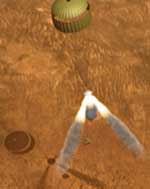Image credit: NASA/JPL
The odds aren't great. For every three missions sent to Mars, two fail. With NASA's twin rovers, Spirit and Opportunity, now only a few weeks away from their encounter with the Red Planet, it's important to appreciate the challenges they still have to face. Already in space for five months, they've endured several solar storms. But the hardest work is still to come: they have to decelerate through the atmosphere, deploy their parachutes, and then land on their airbags.
Two out of three missions to the red planet have failed. One reason there have been so many losses is that there have been so many attempts. "Mars is a favorite target," says Dr. Firouz Naderi, manager of the Mars Program Office at the Jet Propulsion Laboratory. "We -- the United States and former USSR -- have been going to Mars for 40 years. The first time we flew by a planet, it was Mars. The first time we orbited a planet, it was Mars. The first time we landed on a planet it was Mars, and the first time we roved around the surface of a planet, it was Mars. We go there often."
Another reason is that getting to Mars is hard.
To get there, Spirit and Opportunity, the two Mars Exploration Rovers launched this past June and July, will have to fly through about 483 million kilometers (300 million miles) of deep space and target a very precise spot to land. Adjustments to their flight paths can be made along the way, but a small trajectory error can result in a big detour and or even missing the planet completely.
The space environment isn't friendly. Hazards range from what engineers call "single event upsets," as when a stray particle of energy passes through a chip in the spacecraft's computer causing a glitch and possibly corrupting data, to massive solar flares, such as the ones that occurred this fall, that can damage or even destroy spacecraft electronics.
The road to the launch pad is nearly as daunting as the journey to Mars. Even before the trip to Mars can begin, a craft must be built that not only can make the arduous trip but can complete its science mission once it arrives. Nothing less than exceptional technology and planning is required.
If getting to Mars is hard, landing there is even harder. "One colleague describes the entry, descent and landing as six minutes of terror," says Naderi.
Spirit and Opportunity will enter the martian space traveling 19,300 kilometers per hour (12,000 miles per hour). "During the first four minutes into descent, we use friction with the atmosphere to slow us down considerably," says Naderi. "However, at the end of this phase, we're still traveling at 1,600 kilometers per hour (1,000 miles per hour), but now we have only 100 seconds left and are at the altitude that a commercial airliner typically flies. Things need to happen in a hurry. A parachute opens to slow the spacecraft down to 'only' 321 kilometers per hour (200 miles per hour), but now we have only 6 seconds left and are only 91 meters (100 yards) off the ground. Now, the retro rockets fire to bring the spacecraft down to zero velocity, and we're the height of a four-story building above the surface. The spacecraft freefalls the rest of the way cocooned in airbags to cushion the blow. It hits the ground at 48 kilometers per hour (30 miles per hour) or 80 kilometers per hour (50 miles per hour) if it is windy. It bounces as high as a four-story building and continues to bounce afterward, perhaps 30 times all together. What's inside the airbag weighs 453 kilograms (half a ton). So, the challenge of entry, descent and landing is how to get something that massive traveling at 19,300 kilometers per hour (12,000 miles per hour) slowed down in six minutes to have a chance of survival."
Mars doesn't exactly put out a welcome mat. Landing is complicated by difficult terrain. The martian surface is full of obstacles--massive impact craters, cliffs, cracks and jagged boulders. Even the toughest airbag can be punctured if it hits a bad rock. Unpredictable winds can also stir up further complications.
No matter how hard it is, getting to Mars is just the beginning. "The challenge after we land," says Rob Manning, manager of Mars Exploration Rovers entry, descent and landing operations, "is how to get the vehicle out of its cramped cocoon and into a vehicle roving in such a way as to please the scientists."
The rewards are great. "Mars is the most Earth-like of the planets in our solar system," says Naderi. "It has the potential to have been an abode of life."
The risks are also great. "We do everything humanly possible and try to avoid human mistakes," says Naderi. "That's why we check, double check, test and test again and then have independent eyes check everything again. Humans, even very smart humans, are fallible particularly when many thousands of parameters are involved. But even if you have done the best engineering possible, you still don't know what Mars has in store for you on the day your arrive. Mars can get you."
"We are in a tough business," says Naderi. "It is like climbing Mt. Everest. No matter how good you are, you are going to lose your grip sometimes and fall back. Then you have a choice, either retreat to the relative comfort and safety of the base camp, or get up, dust yourself off, get a firmer grip and a surer toehold and head back up for the summit. The space business is not about base camps. It is about summits. And, the exhilaration of discoveries you make once you get there. That is what drives you on."
NASA/JPL News Release
 Universe Today
Universe Today
